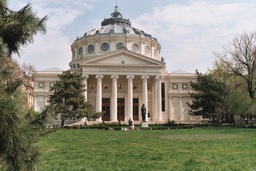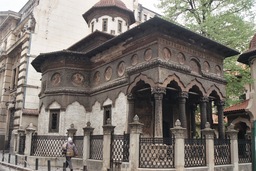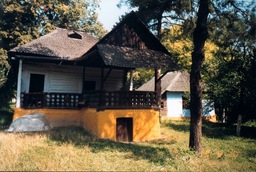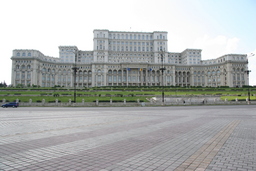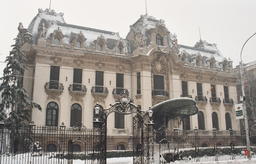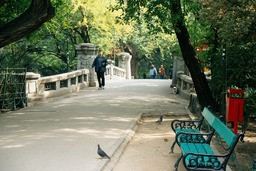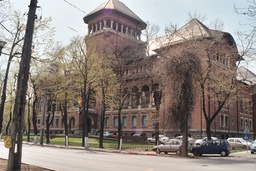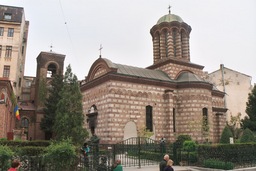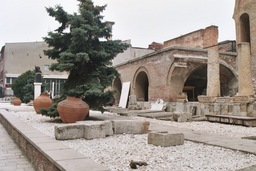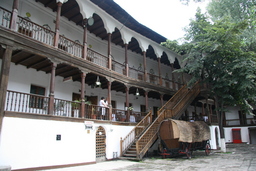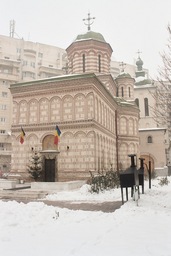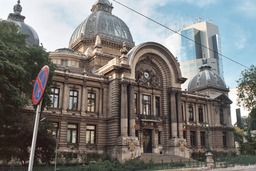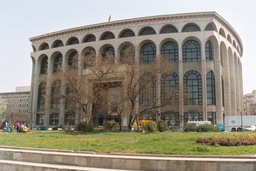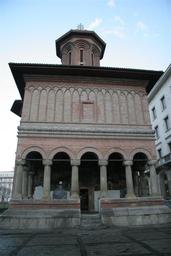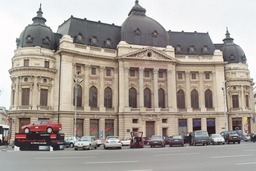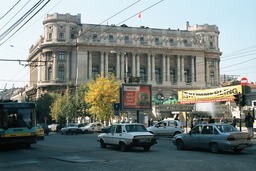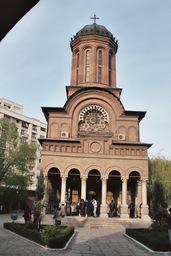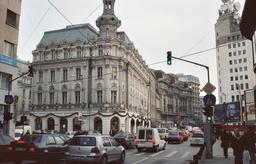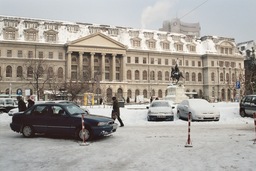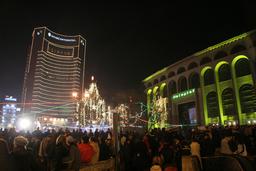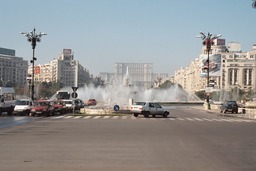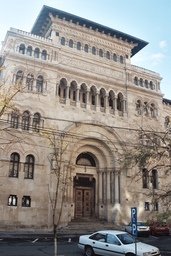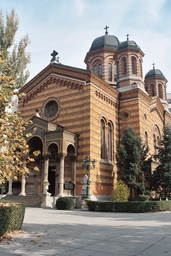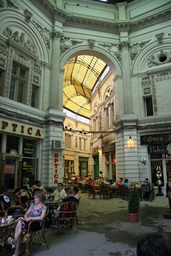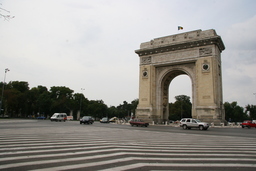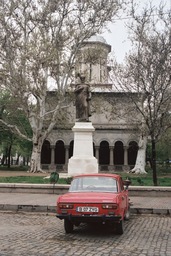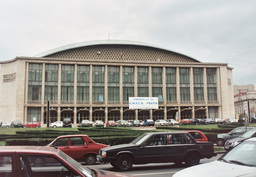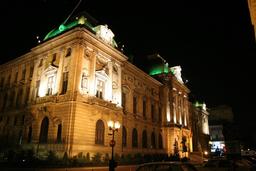|
Click to see larger pictures |
Romanian Atheneum (Ateneul Roman)
This is Bucharest's most prestigious concert hall and one of the most beautiful buildings in the city. It was built in 1888 in neo-classical style after a design by the French architect Albert Galleron. The project was conceived by the diplomat Constantin Exarcu and the money for the completion of the building were gathered in a public collection in which people were asked to "give a leu for the Atheneum" (The "leu" being the currency of Romania). With its 40 m high dome and the Doric columns it resembles an ancient temple. The beautiful facade is adorned with mosaics of five Romanian rulers. On the inside there are scenes from Romanian history. This is the place to hear classical music in Bucharest. The resident orchestra is George Enescu Philarmonic. Address: Piata Revolutiei (Revolutiei Square).|
Click to see larger pictures |
Stavropoleos Church (Biserica Stavropoleos)
This small church is one of the most beautiful in the city. It was built in 1724 during the ruling of Phanariot Prince Nicolae Mavrocordat by the Greek monk Ioanichie. The church is representative for the Brancovenesc style which blends Ottoman and Western elements together with traditional Romanian architectural forms. The inside is equally beautiful, with wood and stone carvings and paintings and frescoes. Address: junction of Postei Street with Stavropoleos Street.|
Click to see larger pictures |
The Village Museum (Muzeul Satului)
The Village Museum was established in 1936 and it contains over 300 wooden houses, windmills, churches etc. from all over the country. If you don't plan to visit Romania's rural areas - and even if you do - you shouldn't miss this museum which is one of the largest of its kind in Europe. Many of the buildings are originals which were brought here in pieces and reassembled. The oldest houses date as far back as the 17C. Behind the project from the start was ethnographer Dimitrie Gusti (1880 - 1955) who wanted the museum to mirror as closely as possible the aspects of the rural life. Because of this the museum is organized as a real village, with clusters of houses being linked by winding paths. This makes for a pleasant stroll especially if you find yourself in Bucharest during the summer, when the city is hot and dusty. Sometimes the museum hosts crafts fairs and folk music and dance festivals. Address: Soseaua Kisellef 28 -30.|
Click to see larger pictures |
National Art Museum (former Royal Palace)
The imposing building which used to be the Royal Palace is located in the Revolution Square (Piata Revolutiei), in the northwestern corner. It was first built around 1815 by prince Dinicu Golescu and it underwent changes over several decades. The building was remodeled in 1882-1885 after plans by the French architect Paul Gottereau only to be rebuilt in 1930-1938 after being damaged in a fire in 1926. Starting with 1948 the palace houses the National Art Museum and it displays an extensive collection of Romanian and European art dating from the 15th to the 20th century. The building was damaged during the events of December 1989 and was closed for several years for repairs. Address: Calea Victoriei 49-53.|
Click to see larger pictures |
The Parliament Palace (Palatul Parlamentului)
Because I grew up in Bucharest I absolutely hate this big ugly Soviet-style building which represents the peak of Ceausescu's megalomania. Even though I was young at the time I remember a little about how this part of the city used to look before they tore it down for the civic center. Many old beautiful buildings were demolished to make way for this monstrosity. I remember a joke that was going around at the time: the boulevard that ends with the Parliament Palace (which used to be called The House of the People) was to be called "The Victory of Socialism" and the joke was that in fact its name is "The Victory of Socialism against Bucharest". But I know that this building is a big tourist attraction in Bucharest (the second largest building in the world in terms of surface, competing with the Pentagon in size). That's why I decided to include it in this guide. I visited the building once, when they opened it for public in 1990 and the rooms are the biggest I've seen in my life. The building is now used as the parliament house as well as for conferences and exhibitions and can be visited by guided tours. Address: Blvd Unirii|
Click to see larger pictures |
Cantacuzino Palace (Palatul Cantacuzino)
This palace was designed by the architect I.D.Berindei in French baroque style and construction was started in 1899. Above the main entrance there is a giant shell-shaped porte-cochere; two stone lions guard the entrance. George Enescu - Romania's national composer - lived here for a period of time. The building belonged to his wife Maria Cantacuzino. In fact Enescu preferred a life of simplicity and he and his wife chose to live in a smaller town house that previously housed the administrative staff of the palace; this house is located behind the main palace. Nowadays the palace houses the George Enescu Museum which displays the musicians manuscripts (scores of his compositions) and personal belongings like one of his first violins. Address: Calea Victoriei 141|
Click to see larger pictures |
Cismigiu Gardens (Gradina Cismigiu)
In the very center of Bucharest there is a place where one can take a break from Bucharest for a few hours. Cismigiu is located close to Universitatii Square, across the City Hall building. It is Bucharest's oldest park and a great place to stroll and enjoy the peace that one can feel finding such a place in the middle of a hectic city. Among the lawns and trees and the winding paths you'll find a lake with rowboat rentals, a beer garden, a playground for children, a chess area where old people play tournaments and plenty of park benches for relaxing and people watching. Sometimes there are Sunday concerts at the gazebo. Cismigiu was first designed and laid out in 1830 by the German landscape architect Carl Meyer, on the commision of Prince Gheorghe Bibescu, but it wasn't completed until 1860. More than 30,000 trees and plants were brought in from the Romanian mountains to be planted on the 17 hectares park. Address: Blvd Regina Elisabeta.|
Click to see larger pictures |
Museum of Romanian Peasant (Muzeul Taranului Roman)
The Museum of Romanian Peasant is the winner of the European Museum of the Year Award for year 1996. A short visit to the museum will convince you that the award is well deserved. The collection includes 18000 pieces of pottery and 20000 examples of national dress from all over the country, as well as carpets, icons, furniture, photographs and films documenting the customs of rural life. But what makes it special is the way the collection is arranged; the museum looks more like an art gallery than a museum. The display information is hand written on pieces of paper or illustrated by freehand sketches. In one of the galleries you can see a wooden church and in another a wooden peasant house. They also have some beautiful "troite" (crosses placed at crossroads or at the edge of a village).The museum building has an interesting story as well. The museum was founded in 1905 under the name of Ethnographical and National Art Museum. In 1906 Carol I laid the foundation for the present building; the construction was stopped in 1916 and restarted in 1932. It was completed only in 1935, 29 years after it was started. The red-brick building is an illustration of the neo-Romanian style ispired from the traditional architecture. In 1953, the communists "liberated" the building and sent the collection away to another location. The building was turned into a museum dedicated to the history of the Communist Party. In 1990 the museum returned to its old location. Address: Kiseleff 3
|
Click to see larger pictures |
The Old Court Church (Biserica Curtea Veche)
The Old Court Church (also called the Old Princely Church) is the oldest church in Bucharest. Its building started in 1558 during the reign of Mircea Ciobanul (Prince Mircea the Shepherd) and was finished by his son in 1591. The church was built in the Wallachian architectural style of the 16th century. The exterior decoration is made of brick stripes alternating with plaster stripes. The church was restored after a fire in 1847 and then again between the years of 1928 - 1938 by the Commission of Historical Monuments, which tried to bring the church to its original appearance. This church was the coronation place of Wallachia's ruling princes for almost three centuries (from the second half of the 16th century to the first half of the 19th century). The beautiful carved door was added in the early 18th century by Prince Stefan Cantacuzino. The interior has been blackened with time but you can still admire the beautiful frescoes, some dating from the 16th century. On the left side of the portal, facing the apse, are the murals of the church's founders: Mircea Ciobanul (whose tombstone is within the church) and his wife, Lady Chiajna; on the right side of the portal are the murals depicting Prince Stefan Cantacuzino and his wife, Lady Pauna. Address: Str. Franceza 33|
Click to see larger pictures |
The Old Court (Curtea Veche)
The oldest part of Bucharest lies around The Old Princely Court (Curtea Veche) at the end of Str. Franceza. Archaeologists believe that this area was inhabitated long before the 14th century because of pieces found here. But this area's time of glory came in the 15th century when the reigning prince of Wallachia, Vlad the Impaler built his fortress here. Vlad's followers (like Price Mircea Ciobanul - Mircea the Shepherd which ruled between 1545-52 and his successors between 1545-59 who also built the nearby church) continued the add to the building, rebuilding, fortifying and modifying the fortress to their needs. After almost 4 centuries, in the 18th century the building was left to ruins and the rulers of Wallachia moved to the New Court in Dealul Spirii. A museum was founded in 1972 when the archaeological diggings revealed the remains of the fortress. All that is left today is truncated pieces of wall and a few arcades. Address: Str. Franceza 23-31|
Click to see larger pictures |
Manuc's Inn (Hanul lui Manuc)
Manuc's Inn is the best preserved of Bucharest's old inns. It was built around 1808 to shelter travelling merchants. The inn is also one of Bucharest's historical building. Its owner, an influential Armenian called Emanuel Marzaian (better know as Manuc Bey hence the name of the place) offered the building for the signing in 1812 of the treaty that ended the Russo-Turkish war and resulted in the gain of Bessarabia by Russia. The treaty is known as the Treaty of Bucharest (1812). The building has the two tier galleries featured by the caravanserais that were common all over the Otoman Empire. Today, Manuc's Inn functions as a hotel-restaurant and winecellar. Address: Str Franceza 64.|
Click to see larger pictures |
Mihai Voda Church (Biserica Mihai Voda)
To make way for his civic center Ceausescu ordered the demolition of all the buildings located in and around Unirii Square. The Brancovenesc Hospital, the Sf. Vineri Church, the Sf. Spiridon Church, the Vacaresti Monastery and many others historic buildings and monuments as well as lots of private houses were virtually wiped out. I don't know due to which circumstances, but it happened that a few old churches were sparred from demolition. However, they were moved from their initial location, and hidden from sight behind the grey apartment complexes of the new civic center. Mihai Voda is one of these churches. It was moved 280m on rails and dumped in a back yard behind some blocks of flats. Once a beautiful monastery, built in 1591 by the great voivode Michael the Brave, its medieval cloister and old buildings were demolished and only the church and the gate tower survived. I don't remember how the monastery looked before Ceausescu's ordered it being moved (and parts of it destroyed), I was very little then. But the church seems to blossom and every time I visit it looks better and better despite its sad location. One of my favourite architectural details is the beautiful sculpted frame of the main door. Don't forget to take a look at it. Address: Str. Sapientei|
Click to see larger pictures |
Romanian Savings Bank or CEC Building
This beautiful building was designed in eclectic style by the French architect Paul Gottereau. Its construction began in 1894 on the site of a 16th century monastery Sf. Ioan cel Nou. This was the only bank that was allowed to do business during communism. Address: Calea Victoriei 13.|
Click to see larger pictures |
National Theater (Teatrul National)
The stocky building sitting on one of the corners of University Square is the National Theater. It was built in 1973 after plans by a group of Romanian architects. The old building of the National Theater was destroyed during the WWII. Originally the building had a different facade, modeled after the architecture of Moldova's monasteries but in 1984 it was remodeled and got its present massive shape. The theatre has 4 performance halls.The National Theater is named after the Romanian playwright and short-story writer Ion Luca Caragiale (1852-1912). His plays made fun of the politics and politicians and of the Romanian society of that day. For example the play that is considered to be his masterpiece, "A Lost Letter", written in 1884, describes a provincial government election won by a blackmailer. It's amazing how his works have the same power today as they did a century ago. Not only that, but recently I saw one of his plays being performed in California and I was surprized to see how the American public of today can relate to his story written in 1880.
Last, if you feel like having a refreshment, you'll find two bars located on top of the National Theater. One is a open terrace bar called "La Motoare", open only in summer, while the other one called "Laptaria lui Enache" is open during fall, winter and spring. They are usually crowded, especially in the late afternoon and evening and especially in the summer when it's difficult to find a table before 2AM in the morning. If you find a table, be prepared to share it. At Laptarie you can catch live music most of the evenings.
|
Click to see larger pictures |
Cretulescu Church (Biserica Cretulescu)
On one of the corners of Piata Revolutiei, next to the former Royal Palace, lies the beautiful red brick Cretulescu church, one of the oldest churches in Bucharest. It was commisioned in 1722 by the boyar Iordache Cretulescu and his wife Safta, a daughter of prince Constantin Brancoveanu. The church is built in the style created by Constantin Brancoveanu, a seventeenth century ruler of Wallachia, who commisioned numerous buildings during his reign and set out to create a distinctive national genre of architecture. The Brâncovenesc or Brancovean Style blends Byzantine and Western architectural elements together with indigeneous forms. Another fine example of this style is Mogosoaia palace, outside Bucharest. The church suffered damage during the 1989 revolution but was recently restored. The frescoes in the porch are especially beautiful. Inside there still can be seen fragments of the late nineteen century frescoes (1859 - 1860) done by Gheorghe Tattarescu, a great Romanian painter. To the side of the church stands a memorial bust of Corneliu Coposu who spent 17 years in prison for his anti-communist activities and was awarded the Legion d'Honeur by French government. Address: Calea Victoriei 45 A.|
Click to see larger pictures |
Central University Library (Biblioteca Centrala Universitara)
The Central University Library is a beautifully ornated building located opposite the Royal Palace in the Revolution Square. The library was founded by king Carol I and the building was designed by the French architect Paul Gottereau, who also designed the National Savings Bank (CEC) building. The building was heavily damaged during the December 1989 movement but was later restored and now it looks really pretty. Address: Piata Revolutiei|
Click to see larger pictures |
The Army Club (Cercul Militar National)
This highly ornate building was designed in French neo-Classical style by Dumitru Maimarolu, Victor Stefanescu and Ernest Doneaud. Construction started in 1911 and ended in 1923 with most of the funds being donated by the Romanian Army officers. The Army Club replaced the monastery church of Sarindar which used to sit here. Address: junction of Calea Victoriei/Regina Elisabeta|
Click to see larger pictures |
Antim Monastery
Antim Monastery is a beautiful complex built in Brancovenesque style. It was completed in 1715 after plans by Antim Ivireanu who was the metropolitan bishop of Wallachia. The complex is located very close to the Palace of Parliament and similar to Mihai Voda Church a part of it was moved to make way for Ceausescu's urbanization plans. It is located behind apartment buildings, hidden from sight. Address: Str. Antim 29|
Click to see larger pictures |
Calea Victoriei
Calea Victoriei (Victory Road) is one of Bucharest's most charming streets. It was built as a main road in 1692 under orders from Constantin Brancoveanu who needed a road to link his palace at Mogosoaia with the Old Court. In the beginning the street was known as Podul Mogosoaia - Mogosoaia Bridge - because it was paved with wood. In 1878 after the Romanian War of Independence the street's name became Calea Victoriei.Between the two world wars Calea Victoriei became one of the most fashionable streets. Following this avenue from Piata Natiunilor Unite to Piata Victoriei you'll find some of the most beautiful buildings in Bucharest. Among these are Stavropoleos Church - on Str. Stavropoleous, few second away from Calea Victoriei, the National Savings Bank or CEC building, the Art Deco Telephone Palace, the Cretulescu Church, the Central University Library, the Romanian Atheneum, the Royal Palace which today houses the National Art Museum and the Cantacuzino Palace.
|
Click to see larger pictures |
Bucharest University
Bucharest University is dominating one of the corners of University Square. The old building, in neoclassic style is facing Regina Elisabeta boulevard. It was started in 1857 and finished in 1859. The buildings on the sides were built in 1912-1916. The University as an institution was created in 1864 by Alexandru Ioan Cuza, ruler of the newly united principalities, Wallachia and Moldova. All around the building you can find stalls selling secondhand books. Address: Piata Universitatii.|
Click to see larger pictures |
University Square (Piata Universitatii)
In the last 15 years University Square has proved to be a popular railing point at the time of national crisis as well as celebration: people gathered here during the 1989 revolution and the sad events of June 1990 and they continue to gather here every time the national team wins a soccer game (which unfortunatelly doesn't happen very often these days). If you see a lot of people loitering around the underground passage entrance in front of the National Theater is because it's probably the most popular meeting place in Bucharest. It's a place buzzing with crowds and traffic, a true center of activity. The square is surrounded by interesting architecture starting with the University of Bucharest building on the square's northwestern corner. Facing the university there are four statues of illustrious pedagogues and statesmen. On the other northern corner, adjacent to the Intercontinental hotel, is the National Theater of Bucharest. Opposite it lies the beautiful building of the School of Architecture, behind a little square with a small fountain where people stop and sit when the weather is nice. On the southwestern corner of the square, the Bucharest History Museum traces the city history from the beginning to modern days and across from it lies the neo-Classical building of the Coltea Hospital and its lovely church. In the middle of the square, in a little island, there are ten stone crosses that pay homage to those killed during the 1989 revolution. Below the square there is an underground passage with shops and eateries which allows pedestrians to cross to from one side of the square to another and also leads to the subway station.|
Click to see larger pictures |
The Union Square (Piata Unirii)
The Union Square (Piata Unirii) is where the downtown starts. Two of Bucharest subway lines intersect here and the square is the site of one of the city's department stores, Unirea. Unfortunatelly this place was also Ceausescu's playground for experimentation, as the square was caught in his plan for "urbanization" and creation of the ugly soviet style Civic Center. To make way for his Civic Center Ceausescu ordered the demolition of all the buildings located in and around Unirii Square. The Brancovenesc Hospital, the Sf. Vineri Church, the Sf. Spiridon Church, the Vacaresti Monastery and many others historic buildings and monuments as well as lots of private houses were virtually wiped out. It's worth coming here and seeing the Civic Center just for realizing how ugly the architecture is (the blocks of apartments are just ugly, but the fountains along the Unirii boulevard are truly hideous).|
Click to see larger pictures |
Bucharest's School of Architecture
A few steps away from University Square, behind a little square with a fountain lies the building of the School of Architecture. Grigore Cherchez conceived this building in 1912 and it took five years to complete it. By circling the building you'll notice that it is a hybrid. The old wing (which is the one designed by Cherchez), in Brancovenesc style, is a mixture of Eastern and Renaissance motifs, with richly ornated pillars and carvings. This building was dedicated to Ion Mincu, which is considered to be one of the greatest Romanian architects. The new parts of the building are in a modern, cold style.|
Click to see larger pictures |
Domnita Balasa Church
One of the churches located around Union Square (Piata Unirii) that survived Ceausescu's plan for creating the Civic Center is Princess Balasa Church (Biserica Domnita Balasa). Instead, this church had a bit of bad luck in terms of natural elements. The first church on this site was a wooden one built in 1774 but it burned down and was replaced by a stone structure in 1751. The second church was damaged during an earthquake and had to be replaced by a third structure build between 1838-1842. At its turn, this building was damaged by floods and replaced by a fourth church between 1881-1885. This is the ocre striped church that we see today. The current church had to be repaired again after each of the two major 20C earthquakes (1940 and 1977). This is one of the most popular places for weddings in Bucharest and if you come here on Saturdays and Sundays, you are almost certain to see a wedding taking place. The church is located off Piata Unirii and Splaiul Independentei behind the blocks of apartments bordering Unirii Square, and faces the side of the Justice Palace. Princess Balasa Church is named after Wallachia's ruler Brancoveanu's sixth daughter. Her statue stands in the small garden that surrounds the church.|
Click to see larger pictures |
Villacrose and Macca Passages
Villacrosse and Macca passages are two pedestrian alleys roofed with glass and wrought iron and lined with shops, cafes and restaurants. They were built at the end of the 19th century. Entrance from Calea Victoriei across the police headquarters and from E. Carada Street.|
Click to see larger pictures |
The Triumphal Arch (Arcul de Triumf)
In northern Bucharest, along Sos. Kiseleff lies Bucharest's Triumphal Arch (Arcul de Triumf). Modelled on the triumphal arch in Paris, the structure was erected in 1935-1936 to commemorate the creation of Greater Romania which took place in 1918. It sits on the spot where two earlier arches stood: the first arch made of wood and cardboard was erected in 1878 to mark Romania's independence from the Turks; the second arch made of timber was erected in 1922 to mark Ferdinand's entry into Bucharest as the first king of Greater Romania. The current arch is built of concrete and granite. Portraits of King Ferdinand and Queen Marie decorate one face, while the names of battles fought by Romanians during the First World War can be seen on the other face. The portraits of the king and queen were destroyed during the communist rule but they were restored in 1992. The sculptures decorating the arch were created by leading artists of the day, including Ion Jalea, D. Onofrei and Constantin Baraschi.|
Click to see larger pictures |
New Saint Gheorghe Church
The reasons that make me include so many churches in my must see tips on Bucharest are two: first, many churches are among the oldest and most beautiful buildings in the city and second, many of the churches have a very interesting history. That is the case for example with the New St. Gheorghe Church - Biserica Sfantul Gheorghe Nou - which was built between 1705-1706 and holds the tomb of its founder Constantin Brancoveanu. Brancoveanu was Wallachia's ruler from 1688 - 1714 and his political and administrative sharpness brought the country into a period of stability, economic prosperity and cultural boom. Because of his anti-Turkish policy of forming alliances first with Austria and afterwards with Russia, he was denounced to the Ottoman Porte, dethroned and brought to Istanbul. There he was tortured by the Turks and he and and his four sons were beheaded on August 26, 1714. His wife had his corpse exhumed in secret and smuggled back into Romania. She reburried him in secret in the church's court. Because she didn't want the Turks to find out where Brancoveanu was burried she only marked the tomb with a stone, but she had a silver votive light made on which the inscription reads that the New St. Gheorghe Church is the place where voyevode Constantin Brancoveanu was burried.|
Click to see larger pictures |
Sala Palatului
If you feel that you can't have enough of the communist architecture, here is another gem that you can admire. I hope that you can sense the sarcasm in my tone; if not, I want it to make it clear. This one was built in the 1960. You can find it behind the National Art Museum (former Royal Palace). The building was used to host the five-yearly communist party congress.Today it's used as a big venue for concerts and exhibitions.|
Click to see larger pictures |
